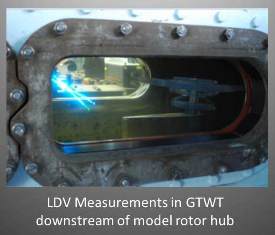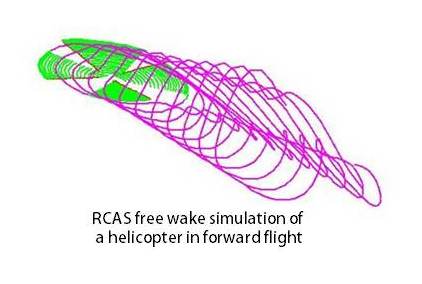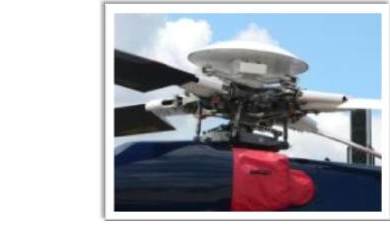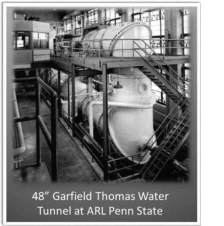Fundamental Physics of Rotor Hub Flows
The rotor hub assembly is the largest contributor to helicopter parasite drag, accounting for up to 30% of the total parasite drag of the vehicle. The ability to reduce rotor hub drag is significant to reducing the total helicopter drag, which is crucial for increasing maximum forward-flight speed, fuel efficiency, and vehicle payload. In addition, it is known that the unsteady wake shed by the main rotor hub causes interference drag and associated flow separation on the engine pylon. Further undesirable interactions between the rotor hub wake and the empennage have been reported during flight testing. Therefore, an improved understanding of rotor hub flows is needed that can be of use in the early design phase.
We conducted experiments in the 48” Garfield Thomas Water Tunnel (GTWT) at theApplied Research Laboratory (ARL) at Penn State University. A scaled model of a notional rotor hub design was tested at quarter- and half-scale Reynolds number with reference to a large helicopter at an advance ratio of 0.2. The main objectives of the experiment were to understand the spatial- and temporal content of the unsteady wake downstream of a rotor hub up to a distance representative of the empennage and tail of a large helicopter. We were able to measure total hub drag and flow diagnostics involving PIV, SPIV and LDV at several locations downstream of the hub.
 Water tunnel testing provides anadvantage with respect toReynolds scaling compared to a wind tunnel due to water having approximately 1/15-times the kinematic viscosity of ambient air. –Our first test conducted at GTWT comprises a unique andvaluable dataset for enhanced understanding of the fundamental physics underlying rotor hub flows and serves as validation data for future CFD analyses in the rotorcraft community.
Water tunnel testing provides anadvantage with respect toReynolds scaling compared to a wind tunnel due to water having approximately 1/15-times the kinematic viscosity of ambient air. –Our first test conducted at GTWT comprises a unique andvaluable dataset for enhanced understanding of the fundamental physics underlying rotor hub flows and serves as validation data for future CFD analyses in the rotorcraft community.
Active Rotor Blades for Performance Enhancement
The use of active methodologies for performance enhancement is an active research area in the rotorcraft community. Previous studies have investigated several harmonically-deployed  active devices and control schemes to reduce power consumption in forward flight. Power savings resulting from these methods are reported to vary from ~1.5%-5%. Our group is working in this area and looking for alternate power saving strategies, for example tailoring the trimmed rotor loading to result in minimum induced power loss while including viscous losses and constraints on the coefficient of lift. Furthermore, we are exploring non-harmonic deployment schedules. At present, we are using the comprehensive rotorcraft analysis code RCAS for our research and are also working towards coupling RCAS with a near-blade Navier-Stokes simulation using OVERFLOW.
active devices and control schemes to reduce power consumption in forward flight. Power savings resulting from these methods are reported to vary from ~1.5%-5%. Our group is working in this area and looking for alternate power saving strategies, for example tailoring the trimmed rotor loading to result in minimum induced power loss while including viscous losses and constraints on the coefficient of lift. Furthermore, we are exploring non-harmonic deployment schedules. At present, we are using the comprehensive rotorcraft analysis code RCAS for our research and are also working towards coupling RCAS with a near-blade Navier-Stokes simulation using OVERFLOW.





